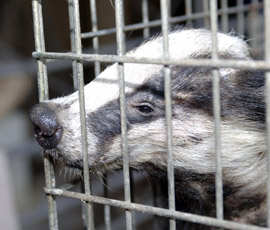National Trust seeks reassurance on badger cull

The National Trust has voiced concern over badger culls taking place in Somerset and Gloucestershire.
Trust officials have written to DEFRA asking for assurances that it is committed to upholding high standards of scientific rigour in the conduct and analysis of the pilot culls.
The culls are being conducted to see whether shooting badgers can be carried out safely, humanely and effectively in a bid to combat bovine tuberculosis.
But criteria around the trials have been changed since culling started in the summer.
Patrick Begg, who leads on bovine TB at the trust, said the organisation recognised that dealing with bovine TB was a complex problem, with strongly held views on all sides.
“The trust’s position on tackling bovine TB is clear: we are in favour of what will work to solve the problem that is affecting so many of our tenants and farmers across the country.”
The trust understood that a comprehensive badger cull could have a significant impact on the incidence of bovine TB – but only if a number of very stringent criteria were met.
These included intensity, longevity and geography.
“We had hoped that the current pilot culls would produce credible evidence on the effectiveness of a humane cull,” said Mr Begg.
The trust would be judging the outcomes of the pilots against the criteria for success set out by the Bourne review of the Randomised Badger Culling Trial (RBCT), he added.
“We’ve recently written to DEFRA asking for their assurance that they are committed to meeting the criteria set out by Professor Bourne and upholding high standards of scientific rigour in the conduct and analysis of these pilots.”
Published in 2007, the Bourne review concluded that cattle-to-cattle transmission, as well as badgers, was very important in high incidence areas and is the main cause of disease spread to new areas.
The study found that reactive culling actually increased bTB infection within culled areas. It found that proactive culling reduced bovine TB in cattle within culled areas, but led to an increase on adjoining unculled land.
It concluded that only sustained and coordinated proactive culling over a very large area would be effective.
Mr Begg outlined four main concerns – including uncertainties over, and changes in, baseline badger population estimates.
“This dimension is fundamental if we are to understand whether the appropriate proportion of animals can be culled as per the criteria set following the RBCT.”
Secondly, the trust was worried about the lengthening of the culls.
Initially, the trials were due to last six weeks. The Somerset cull has been extended to nine weeks and the a decision is awaited on an extension to culling in Gloucestershire.
Thirdly, Mr Begg raised questions over changes to the culling methods employed.
It was clear that free shooting by marksmen – the original preferred method – had been largely abandoned in favour of cage trapping and then dispatch.
Finally, the trust was also concerned over the “apparently now active discussion” of other culling methods for any wider roll out, such as gassing and snaring.
Both these alternative methods had strong experimental evidence bases calling into question whether they could be humane, said Mr Begg.
Natural England is expected to announce imminently whether it will grant an application to extend the period of the Gloucestershire cull.
The government’s chief veterinary officer Nigel Gibbens has advised that the culling period be extended to achieve the earliest and greatest possible impact on bovine TB.
But animal welfare campaigners and some scientists remain opposed to the cull, warning that it could even spread TB as diseased badgers flee the trial zones.
Charity apologises for claim that NFU backs badger gassing
